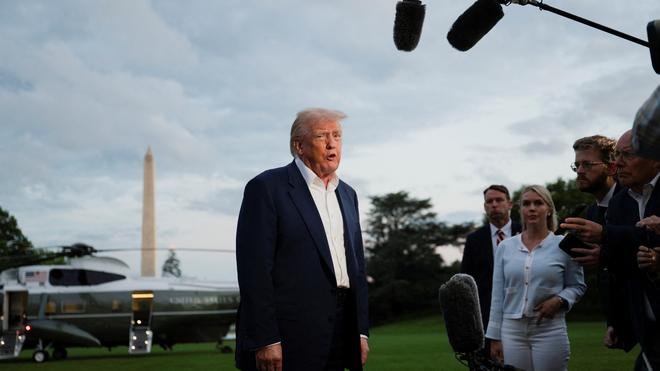U.S. President Donald Trump. | Photo Credit: Reuters
U.S. President Donald Trump has unleashed a seismic shift in the global film industry with his latest policy bombshell: a 100% tariff on all movies produced outside the United States. Announced on May 4, 2025, via his Truth Social platform, this drastic measure aims to revive a struggling Hollywood but risks igniting a trade war with far-reaching consequences. Here’s everything you need to know about this controversial move and its potential impact on the U.S. film industry and beyond.
Why Trump Imposed the 100% Tariff
In his announcement, Trump claimed the American movie industry is “dying a very fast death” due to foreign governments offering lucrative incentives to lure filmmakers away from the U.S. He labeled these incentives a “concerted effort” by other nations, branding them a national security threat. The tariff, Trump argues, will incentivize studios to produce films domestically, revitalizing Hollywood and creating jobs for American workers.
Trump’s rhetoric taps into ongoing concerns about globalization in the film industry. Countries like Canada, Australia, and Ireland have long offered tax breaks and subsidies, attracting major studios to shoot blockbusters overseas. This has led to a decline in domestic production, with Hollywood struggling to compete against cheaper international alternatives.
How the Tariff Will Impact the Film Industry
The 100% tariff will effectively double the cost of importing foreign-made films into the U.S., making it prohibitively expensive for distributors to bring international titles to American audiences. This could have a chilling effect on the availability of foreign films in U.S. theaters, potentially limiting cultural diversity on screens.
However, the policy’s impact on Hollywood is less clear. While it may encourage studios to keep production stateside, the increased costs could strain budgets, especially for independent filmmakers who rely on international co-financing. Moreover, the tariff does not address the lack of domestic tax incentives, which many argue is a key reason for Hollywood’s decline.
Global Reactions and the Threat of Retaliation
Internationally, the announcement has sparked alarm. Leaders in Australia and New Zealand, where film production is a significant economic driver, have vowed to protect their local industries. Australia’s New South Wales and Queensland, hubs for Hollywood shoots, decried the tariff, warning of job losses and economic disruption.
The policy also raises the specter of retaliatory tariffs. If other nations impose similar levies on U.S. films, American studios could lose access to lucrative international markets. This tit-for-tat could escalate into a broader trade war, further destabilizing the global economy.
Challenges in Implementation
Details on how the tariff will be enforced remain murky. Many films involve complex international financing and production arrangements, making it difficult to determine what qualifies as a “foreign” movie. For instance, a Hollywood blockbuster shot partially in Canada could face the tariff, even if it’s produced by an American studio. This ambiguity has left industry professionals scrambling for clarity.
Trump has directed the Department of Commerce and the U.S. Trade Representative to begin implementing the tariff immediately, but experts warn that legal and logistical hurdles could delay or derail the process.
Is Hollywood Really Dying?
Trump’s claim that the U.S. film industry is on its last legs is contentious. In 2024, Hollywood generated $30 billion in revenue, a testament to its enduring global influence. However, rising production costs, labor disputes, and competition from streaming platforms have strained studios. The shift to international production hubs has also reduced jobs in traditional filmmaking centers like Los Angeles.
Critics argue that Trump’s tariff ignores these deeper structural issues. Instead of addressing labor costs or boosting domestic incentives, the policy may simply raise prices for consumers and limit access to diverse content.
Trump’s Broader Trade Agenda
The 100% tariff on films is part of Trump’s aggressive trade strategy, which includes reciprocal tariffs on countries like India and a 145% levy on China. These policies have already roiled global markets, with the S&P 500 and Dow Jones dropping amid fears of a recession. While Trump recently announced a 90-day pause on most tariffs (except those on China), the film tariff appears to be moving forward without delay.
Some analysts see the tariff as a symbolic gesture to rally Trump’s base by targeting Hollywood, an industry often at odds with his administration. Others view it as a risky escalation in an already volatile global trade environment.
What’s Next for Hollywood and Global Cinema?
As the U.S. film industry braces for change, stakeholders are left grappling with uncertainty. Will studios relocate production to the U.S., or will they find loopholes to bypass the tariff? Could this policy spark a renaissance in American filmmaking, or will it isolate Hollywood from the global market? Only time will tell.
For now, the 100% tariff stands as a bold and divisive move, one that could redefine the future of cinema both in the U.S. and abroad. Stay tuned for updates as this story unfolds.

